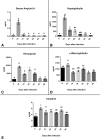Tracking acute phase protein response during acute and chronic Toxoplasma gondii infection
- PMID: 32257894
- PMCID: PMC7081684
- DOI: 10.1186/s42826-019-0007-z
Tracking acute phase protein response during acute and chronic Toxoplasma gondii infection
Abstract
Toxoplasmosis is a disease caused by the protozoan Toxoplasma gondii, which occurs worldwide in mammals and birds. Brain is the primary target organ because Toxoplasma gondii is a ubiquitous intracellular parasite that causes most frequently life-threatening encephalitis in immunocompromised patients. Relation of tissue cysts number, histopathology score and acute phase proteins were investigated. In this study, 36 mice are infected with Me49 strain of Toxoplasma gondii. The control group has 6 healthy mice. After inoculation of Toxoplasma gondii, at 10., 15., 20., 30., 45., 60. days, 6 each mice euthanized after collection of blood samples. Hemopexin, haptoglobulin, macroglobulin, serum amyloid A and clusterin levels are determined by ELISA. Then, brain tissues were investigated histopathologically and lesions were scored. The average cyst numbers were determined by counting three samples (25 μl each) of each brain homogenate under light microscopy. Inflammatory reaction was observed on day 10 days after inoculation (d.a.i.) The lesions were characterized by perivascular mononuclear cell infiltration, focal mononuclear cell infiltration in the meninges, and glial proliferation. Tissue cysts were observed in all Toxoplasma gondii-infected groups. The highest lesion score was observed at 60 d.a.i. And the most tissue cyst number were on day 30. d.a.i. Serum levels of hemopexin, haptoglobulin, macroglobulin, serum amyloid A and clusterin were significantly higher than the control group on day 10-20., 10., 10-30., 10.,10-45 d.a.i., respectively. High level of acute phase proteins in mice on certain days infected with Toxoplasma gondii was exhibited a relationship between brain lesions and tissue cysts.
Keywords: Acute; Acute phase proteins; Chronic; Encephalitis; Toxoplasma gondii.
© The Author(s) 2019.
Conflict of interest statement
Competing interestsThe authors declare that they have no competing interests.
Figures


Similar articles
-
The correlation of TNF alpha levels with acute phase proteins in acute Toxoplasma gondii infection in mice.Exp Parasitol. 2022 Aug;239:108311. doi: 10.1016/j.exppara.2022.108311. Epub 2022 Jun 17. Exp Parasitol. 2022. PMID: 35724932
-
Impact of Engineered Expression of Mitochondrial Association Factor 1b on Toxoplasma gondii Infection and the Host Response in a Mouse Model.mSphere. 2018 Oct 17;3(5):e00471-18. doi: 10.1128/mSphere.00471-18. mSphere. 2018. PMID: 30333181 Free PMC article.
-
[Kinetic distribution of cyst-forming Chinese isolate of Toxoplasma gondii in mice].Zhongguo Ji Sheng Chong Xue Yu Ji Sheng Chong Bing Za Zhi. 2012 Jun 30;30(3):179-83. Zhongguo Ji Sheng Chong Xue Yu Ji Sheng Chong Bing Za Zhi. 2012. PMID: 23072130 Chinese.
-
[Problems and limitations of conventional and innovative methods for the diagnosis of Toxoplasmosis in humans and animals].Parassitologia. 2004 Jun;46(1-2):177-81. Parassitologia. 2004. PMID: 15305712 Review. Italian.
-
A pathway to cure chronic infection with Toxoplasma gondii through immunological intervention.Parasitol Int. 2021 Apr;81:102259. doi: 10.1016/j.parint.2020.102259. Epub 2020 Dec 1. Parasitol Int. 2021. PMID: 33271362 Free PMC article. Review.
Cited by
-
Parasitological, Molecular, and Histopathological Investigation of the Potential Activity of Propolis and Wheat Germ Oil against Acute Toxoplasmosis in Mice.Pharmaceutics. 2023 Feb 1;15(2):478. doi: 10.3390/pharmaceutics15020478. Pharmaceutics. 2023. PMID: 36839800 Free PMC article.
-
Ameliorative effects of propolis and wheat germ oil on acute toxoplasmosis in experimentally infected mice are associated with reduction in parasite burden and restoration of histopathological changes in the brain, uterus, and kidney.Front Vet Sci. 2024 Mar 1;11:1357947. doi: 10.3389/fvets.2024.1357947. eCollection 2024. Front Vet Sci. 2024. PMID: 38496314 Free PMC article.
-
Tamoxifen Increased Parasite Burden and Induced a Series of Histopathological and Immunohistochemical Changes During Chronic Toxoplasmosis in Experimentally Infected Mice.Front Microbiol. 2022 May 30;13:902855. doi: 10.3389/fmicb.2022.902855. eCollection 2022. Front Microbiol. 2022. PMID: 35707167 Free PMC article.
References
-
- Dubey JP, Beattie CP. Toxoplasmosis of animals and man. Boca Raton, Fla.: CRC Press; 1988. http://www.loc.gov/catdir/enhancements/fy0744/87026826-d.html.
-
- Atmaca HT, Kul O, Karakuş E, Terzi OS, Canpolat S, Anteplioğlu T. Astrocytes, microglia/macrophages, and neurons expressing toll-like receptor 11 contribute to innate immunity against encephalitic toxoplasma gondii infection. Neuroscience. 2014;269:184–191. doi: 10.1016/j.neuroscience.2014.03.049. - DOI - PubMed
-
- Dubey JP, Lindsay DS. Opportunistic infections: toxoplasma, Sarcocystis, and microsporidia. Boston, MA: Springer US; 2004. Biology of toxoplasma Gondii in cast and other animals; pp. 1–19.
LinkOut - more resources
Full Text Sources

